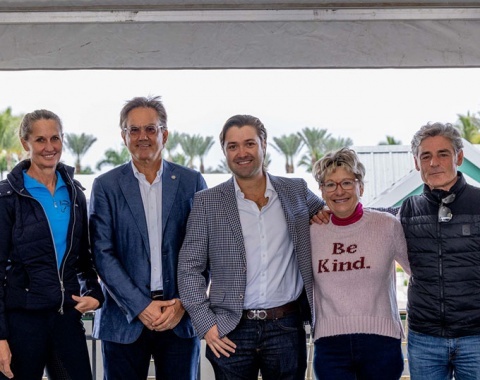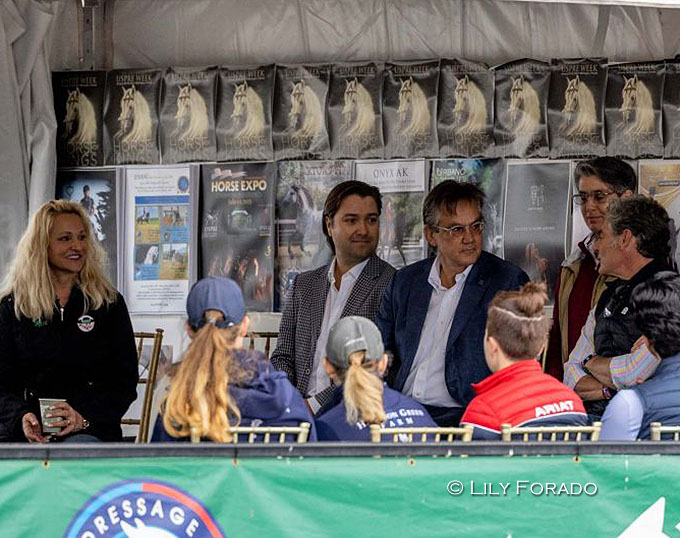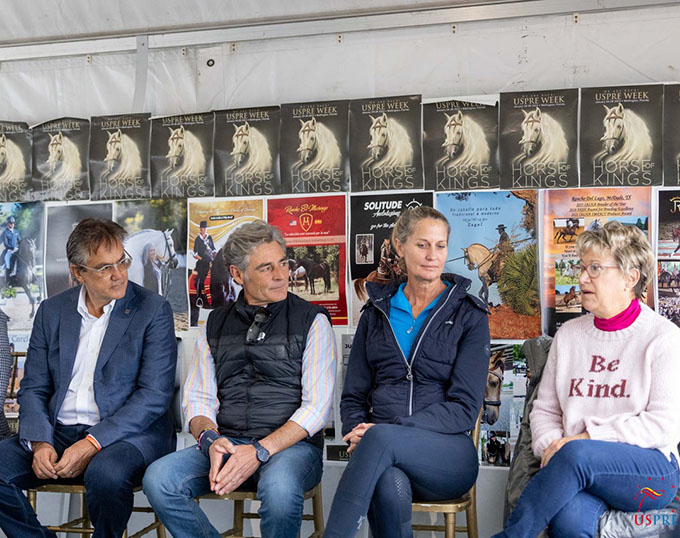
USPRE, the organization whose objective is the promotion of the PRE on American soil, recently held a round table discussion during USPRE week in Wellington about the future of the PRE in sport.
This meeting took place on Saturday 28 January 2023 and multiple experts representing the different areas of dressage: riders, judges and breeders, both national and international, were in attendance.
Expert Discussion
Various topics were addressed, such as the development of the young horse, training, morphology breeding versus sport breeding, judges’ standards, selection, genetics, breeding lineages, etc.
Hosted by USPRE president emeritus Kimberly van Kampen, international breeders from Guatemala and Costa Rica, Christian Moll and Jose Chavarria respectively, Olympic riders Yvonne Losos de Muñiz, Juan Manuel Muñoz and FEI5* judge, Janet Foy participated.
The debate revolved around two central themes: the new tendencies for breeding for sport and the continuously improving role of the PRE in world-class competitive dressage, along with genetics trends.
Mare Power

“The PRE horse is a horse for everything, not just to look at. Previously the horse was more baroque, heavy in comformation, but through the years, this horse has developed a longer neck, better gaits. We, the breeders, have learned where we are going: to produce a horse based on what the market needs, and that is sport. Our horse is loyal, with good character and above all noble and super smart. Today we, the breeders, are facing new challenges and we have to give more opportunities to the mares under saddle. Because of tradition, we just focus on stallions (50 % of our possibilities), and if we start introducing the mares in sport, we will reach more than the 50%. We will get out of that tradition, and we will take advantage of that 50% remaining”.
Look at the Genetics
The breeding topic kept going, and José Chavarria, an award-winning breeder from Costa Rica, provided another interesting perspective: bloodlines. He insisted that all breeders have to ask themselves: “how can we produce a better Spanish horse?”
The Costa Rican breeder stressed that the answer to that question is what drives the breeders to improve generation through generation. One of the tools that he insisted it really helps to produce a good horse, is to look at the genetics.
“The genetics are very, very important, but the stallion selection is key.” Chavarria agreed also on the focus of the mares as Christian Moll did, and both agreed that the mare contributes more than a stallion, even though it would be interesting to look at top stallions in sport and then compare the lines.
SICAB as Reference Point

Romero de Trujillo
He also pointed out that ANCCE has one of the biggest databases in genetics and that information is accessible to everyone through their website. He remarked that previous research in terms of bloodlines, genes is essential.
Training of the Young Horse
The two Olympic riders continued with the debate and targeted the training of the young horse. Yvonne Losos de Muñiz described and explained that the PRE is a total package horse. She declared that the breeding has faced a big change and now the horse looks sportier. In her experience, the sensibility and the trainability are the main strengths for the youngsters.
She admitted that the PRE horses are late developers, that means that they have different phases through their teenage years to adulthood. “When they are 2 to 5 years, they are awkward growing babies with bodies like dinosaurs," Yvonne stated. The audience showed some smiles after that comment. Yvonne also highlighted that when she looks for a PRE one of the most important things she focused on is a good walk in the field.
Juan Manuel Muñoz shared Yvonne’s opinion, but also declared that the PRE is his favourite sport horse. The rider of Fuego de Cardenas reiterated that the PRE horse has a very specific conformation, and the rider has to be smart and patient with his body. More also, he asseverated that PRE horse will give everything but with patience, good trainability, and sensibility with the contact, the results will come sooner or later.

Losos de Muniz and Janet Foy
The attendees gave their various perspectives, but all agreed on the importance of focusing on the training of the young horses. Finally, the round table discussion encouraged the development of selection and relevant standards of sport for this new era of breeding.
Text and Photos © Lily Forado for www.usprea.org
Related Links
The International PRE Community Gathers in Wellington for 2023 USPRE Week